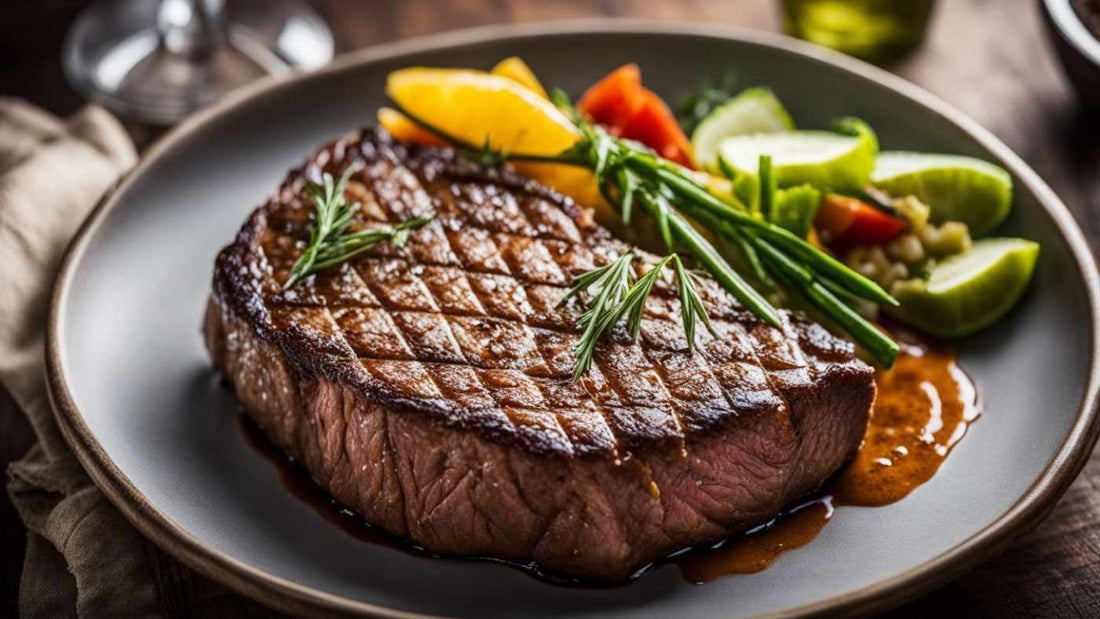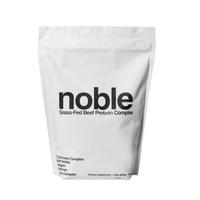
Why Grass-Fed Beef Beats Grain-Fed Beef Every Time!
Share
Are you on a quest for the healthiest, most sustainable beef choice? At Noble Origins, we believe in harnessing the wisdom of ancestral nutrition to guide our modern choices.
This article will explore the nuances between grass-fed and grain-fed beef, from nutrient profiles to environmental footprints.
Our aim?
To empower you with knowledge so you can make choices that nourish your body and respect our planet and its natural ecosystems.
Let's dive in and make sense of the excellent beef debate!
Key Takeaways
- Grass-fed beef has more omega-3 fats and CLA, suitable for heart health. It also has more vitamins A & E.
- Grain-fed beef has higher amounts of monounsaturated fat. This is also healthy but less nutrient-dense than grass-fed.
- The taste differs; grass-fed is earthy, while grain-fed is rich and buttery.
- Grass-fed beef comes from cows that eat a natural diet, making it costlier than grain-fed beef from corn or soy-fed cows.
Grass-fed Beef vs. Grain Fed Beef
When it comes to beef, two popular types are grass-fed and grain-fed. Grass-fed cows consume a natural diet of grass throughout their lives, while grain-fed cows typically feed on corn or soy-based feeds.
The main differences between the two primarily lie in their nutrient and fatty acid composition.
For instance, grass-fed has higher levels of omega-3s and conjugated linoleic acid (CLA) - healthy fats that can benefit heart health.
Equally important is the vitamin content; Grass-fed beef boasts more Vitamin A & E plus antioxidants than its grain counterpart.
Both these types remain an excellent source of high-quality protein, providing essential nutrients for muscle and brain health.

Fatty Acid Composition
Grass-fed beef shines in its fatty acid composition compared to its grain-fed counterpart.
Packed with up to five times as much omega-3 fatty acids, it steps ahead significantly. (1)
Not only that, but the conjugated linoleic acid (CLA) content is about double that in grass-fed beef.
These naturally occurring fats have recognized health benefits, including anti-inflammatory properties and aiding heart health.
Conversely, grain-fed beef has a higher concentration of monounsaturated fat, which also holds beneficial properties for cardiovascular wellness but falls short when considering the overall nutrient richness of grass-fed beef.
The Nutritional Value
Grass-fed beef and grain-fed beef provide different nutritional values.
To help you visualize these differences, here’s a table comparing the nutritional values of grass-fed and grain-fed beef:
| Nutritional Component | Grass-Fed Beef | Grain-Fed Beef |
|---|---|---|
| Monounsaturated Fat | Lower | Higher |
| Omega-3 Fatty Acids | Up to 5x Higher | Lower |
| Conjugated Linoleic Acid (CLA) | About 2x Higher | Lower |
| Vitamins A and E | Higher | Lower |
| Total Fat | Less | More |
It's important to note that grass-fed beef is often more nutrient-dense, offering higher amounts of vitamins A and E.
Moreover, it contains more beneficial omega-3 fatty acids and CLA.
However, it's also worth mentioning that grain-fed beef has more monounsaturated fat, the "heart-healthy" fat.
Choosing between grass-fed and grain-fed beef ultimately depends on your preferences and dietary needs. Both options can be a part of a balanced, nutrient-rich diet.
Grass-fed vs. Grain-fed: A Comparative Analysis
Let's dive into a detailed comparison between grass-fed and grain-fed beef. We'll dissect the differences in taste, health benefits, environmental impact, and cost.
You may have heard varying opinions about the flavor of each type - we’ll explore this in depth.
Moving on to health benefits, there's debate surrounding which one packs a bigger nutritional punch; is grass-fed superior?
On an eco-friendly note, both farming practices impact our environment - let's dissect which has lesser footprints.
Finally, yet importantly, we'll tackle cost - given its high price tag, is grass-fed beef worth it? Join us as we unravel these intricate grass versus grains controversy layers!

Taste
Grass-fed beef offers a distinctly earthy and slightly gamey flavor, often described as more 'natural' by its fans.
This robust taste is partly due to the cow's grass and outdoor forage diet.
On the other hand, grain-fed beef boasts a richer, buttery flavor. The higher fat content adds to its juiciness, making it seem more satisfyingly indulgent on your tongue.
Taste preferences vary among individuals; some people adore the mature taste of grass-fed beef, while others savor the lushness that characterizes grain-fed varieties.
The cooking method also dramatically affects how these tastes come through in your dish!
Health Benefits
Choosing the type of beef you consume can profoundly affect your health. Here are some striking health benefits tied to different types of beef:
- Grass-fed beef contains up to five times as much omega-3 fatty acids, which are crucial for brain health and linked to a lower risk of heart disease.
- The conjugated linoleic acid (CLA) level, a potent antioxidant, is about twice as high in grass-fed beef. Eating foods with higher CLA levels may provide significant health benefits.
- Vitamins A and E are vital in maintaining healthy vision and immune function - grass-fed beef has higher amounts.
- For those watching their fat intake, grass-fed beef typically has less total fat than grain-fed beef, potentially aiding in weight management.
- Grass-fed beef generally packs more nutrients per serving; this includes a higher concentration of vitamins A and E than grain-fed alternatives.
- Grain-fed beef provides ample high-quality protein - essential for muscle growth and repair.
- It also offers significant nutritional value from nutrients such as iron and zinc.
- The taste preference often leans towards grain-fed beef due to its marbled fat content, which provides a rich and flavorful taste.
Environmental Impact
Grass-fed systems generally require more acreage, potentially leading to deforestation. These cattle are also susceptible to harsh weather conditions like wind and rain.
On the other hand, grain-fed operations concentrate large amounts of manure and nutrients in a small area, increasing pollution risks.
However, they produce more meat per unit of land than grass-based farms.
Grass-fed cattle often boast a lower carbon footprint due to reduced transportation needs; most local farmers rely on grain-feeding methods instead for practical reasons.
Cost
Grass-fed beef often rings up at a higher price than its grain-fed counterpart. This difference in cost is primarily due to the more extended growth period and more expensive feeding practices associated with raising grass-fed cattle.
However, some argue that grass-fed beef's nutritional benefits and superior taste justify this expense.
If budget constraints are a factor, consider occasionally incorporating grass-fed beef into your diet rather than making it an everyday staple.
Availability can also influence cost as not all areas have easy access to grass-fed options, which could lead to higher prices for those who choose to purchase this type of meat.
The Bottom Line: Is Grass-fed Beef Worth the Extra Cost?
Grass-fed beef, while pricier than its grain-fed counterpart, stands out as a premium choice for several compelling reasons.
This higher cost reflects its superior nutritional profile and the ethical approach to cattle rearing.
Raised on their natural diets, grass-fed cattle aren't subjected to antibiotics or growth hormones, leading to a beef quality many regard unparalleled.
For those prioritizing health, grass-fed beef is a clear winner. It boasts higher Omega-3 fatty acids and conjugated linoleic acid (CLA), celebrated for its health advantages.
Additionally, you'll benefit from elevated amounts of vitamins A and E.
While grain-fed beef might appeal to budget-conscious shoppers and those who favor its distinct fat marbling, weighing the broader implications is essential.
Beyond just price and taste, consider each beef type's animal welfare, environmental impact, and health benefits.
In the bigger picture, grass-fed beef emerges as a holistic choice for the health-conscious and ethically-minded consumer.

Conclusion
When choosing between grass-fed and grain-fed beef, consider more than taste—nutrition, ethics, and overall health.
Grass-fed beef stands out with its enhanced nutrient profile, closely mirroring ancestral nutrition principles.
While grain-fed beef has flavor nuances, grass-fed beef's health and ethical advantages are undeniable.
For those who truly value the essence of animal-based nutrition and its broader impact, grass-fed beef is the clear choice.
And if you're looking to further embrace this nutritional philosophy, Noble Origins' grass-fed animal-based protein powders are a perfect complement.
Dive into a world of quality, sustainability, and optimal health with us.
FAQs
What is the primary distinction between grass-fed and grain-fed beef?
Grass-fed beef is sourced from cows that predominantly consume grass. In contrast, grain-fed beef comes from cows fed a diet mainly based on corn and soy, especially in the latter part of their lives. This difference in diet significantly affects the beef's nutrient composition.
How does the health profile of grass-fed beef compare to grain-fed beef?
Grass-fed beef typically contains less total fat than grain-fed beef. However, it boasts higher omega-3 fatty acids, conjugated linoleic acid (CLA), and specific vitamins like vitamins A and E. Both types of beef are rich in essential nutrients, but grass-fed beef offers a slightly enhanced nutritional profile.
Why does grass-fed beef have a distinct taste compared to grain-fed beef?
The cow's diet is pivotal in determining the beef's flavor. Grass-fed beef tends to have a leaner texture and a more pronounced, gamey taste, while grain-fed beef offers a milder flavor due to its corn and soy-based diet.
Are there potential concerns associated with consuming grain-fed beef?
Yes, there are debates surrounding grain-fed cattle, especially those raised in Concentrated Animal Feeding Operations (CAFOs). Concerns include consuming GMO grains treated with Glyphosate and using growth hormones and antibiotics.
Is it accurate to say that all beef from South Africa is grass-fed?
No, not all South African beef is exclusively grass-fed. The feeding practices vary based on local farming methods, availability of grazing lands, and feed sourcing.
What's the typical feeding practice for Wagyu Beef?
Originally from Japan, Wagyu beef is often reared on a mixed feeding program that includes grains and other fodder. However, the specific diet is determined by individual farmers and their farming operations.
Related Studies
- An article from Oregon State states that grass-fed beef contains up to five times as much omega-3 fatty acids, which are crucial for brain health and linked to a lower risk of heart disease.



